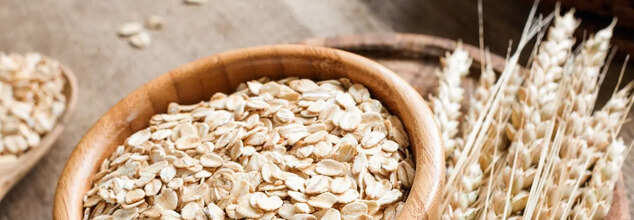- Health Conditions A-Z
- Health & Wellness
- Nutrition
- Fitness
- Health News
- Ayurveda
- Videos
- Medicine A-Z
- Parenting
- Web Stories
Are Oats Really Healthy? Impact Of Nickel On Your Body

Oats (Credit: Canva)
Nickel is a chemical element found in many food items like chocolate, oats, nuts, shellfish, tea, gelatin, and canned fruits and vegetables. The amount of nickel in a food depends on the nickel content in the soil where it was grown. The typical daily dietary intake of nickel is 70–400 μg/d, but diets high in nickel-rich foods can supply more than 900 μg/d.
This metal can also be released from stainless steel pots and pans, especially when cooking acidic foods like tomatoes, lemons, or vinegar. While nickel is not dangerous for someone who is not allergic to it, it can cause problems for those with a sensitivity.
How To Identify Nickel Allergy?
Approximately 8% to 19% of the population in Europe has a nickel allergy. This is usually a reaction to physical touch, like touching a piece of equipment made of nickel. However, other people react to nickel introduced through their diet. Even in low doses, their skin can react in a similar manner, producing contact dermatitis. This includes symptoms like redness, irritation, inflammation, or rashes on the skin.
For some, the reaction goes beyond skin irritation. Symptoms can include headaches, stomachaches, and respiratory symptoms, which are collectively known as Systemic Nickel Allergy Syndrome (SNAS). Doctors have also linked nickel sensitivity to symptoms of fibromyalgia, chronic fatigue, and other chronic diseases. However, for those without sensitivity, moderate levels of nickel in foods are generally safe. It is also recommended to avoid eating nickel-rich foods on an empty stomach, as this can worsen the effects.
Sources Of Nickel
The level of nickel in foods depends on the plant species and the nickel content in the soil. In seafood, it depends on the aquatic environment. Some foods are known to contain more nickel than others. For instance, flour and grains, such as oats, buckwheat, whole wheat, and brown rice, are high in nickel. Seeds like sunflower, sesame, and alfalfa also contain moderate amounts of nickel.
Seafood and shellfish, including shrimp, mussels, and crawfish, are rich in nickel, and certain legumes like chickpeas, lentils, peanuts, and soy products are also high in nickel. Green vegetables such as kale, spinach, lettuce, and cabbage should be avoided or eaten in moderation. Most fruits are safe to eat, but figs, pineapples, prunes, and raspberries are more likely to trigger a reaction. Chocolate, due to its fat content in cocoa, can increase the potential for nickel-related reactions.
If you are reactive to foods containing nickel, your doctor may recommend a low-nickel diet. Alternatives like cornmeal, corn tortillas, and cornflakes are good substitutes for wheat-based foods. Non-seafood meats, such as chicken, beef, and pork, are low in nickel and safe to consume. Most fruits, including pears, apples, strawberries, and grapes, are also suitable for a low-nickel diet. Polished rice and root vegetables like potatoes, carrots, and sweet potatoes contain only trace amounts of nickel, making them safe choices.
Managing a nickel allergy requires awareness of high-nickel foods and suitable alternatives. With a few adjustments, it is possible to maintain a healthy diet while avoiding symptoms.
On Antidepressants Or Blood Pressure Pills? Avoid These Halloween Candies, Experts Say

Credits: Canva
Halloween may bring an abundance of sweets and chocolate, but a few of these treats could carry health risks that have nothing to do with sugar. Mixing certain confectionery with prescription medication can cause unexpected side effects, especially for people being treated for depression, anxiety, or heart conditions. Kiran Jones, a Clinical Pharmacist at Oxford Online Pharmacy, explained which medicines could be affected, ranging from stronger adverse reactions to reduced drug effectiveness, and what ingredients should be avoided.
Avoid Halloween Sweets If You Are on Medication
While enjoying Halloween treats in moderation is harmless for most people, those taking regular medication should be cautious. Some common ingredients in candies, especially artificial sweeteners, caffeine, liquorice, and food coloring can interfere with how medicines work. Even small amounts can alter absorption, increase side effects, or counteract the intended effect of the drug.
Depression, Anxiety and Parkinson’s Medications
Artificial sweeteners such as aspartame can interfere with neurotransmitters affected by Monoamine Oxidase Inhibitors (MAOIs). These medicines are prescribed to treat depression, anxiety, and Parkinson’s disease by preventing the breakdown of neurotransmitters in the brain.
When combined with aspartame, these drugs can lead to an excessive build-up of neurotransmitters, resulting in high blood pressure, headaches, nervousness, or trouble sleeping.
Jones explained, “People taking these medications should avoid or limit foods containing aspartame to prevent these potentially serious reactions.”
ADHD, Anti-Anxiety and Blood Pressure Medications
Sugar-free sweets, diet drinks, and low-calorie snacks often contain artificial sweeteners like aspartame, while caffeine is commonly found in chocolate and coffee-flavoured candies. For those on ADHD medication, anti-anxiety pills, or blood pressure drugs, caffeine can significantly alter how the medicine behaves.
It can heighten the stimulant effects of drugs such as Adderall while weakening the calming impact of SSRIs. Similarly, caffeine may counteract beta-blockers used for blood pressure control by raising heart rate and blood pressure. This interaction can cause symptoms like palpitations, restlessness, poor sleep, and in severe cases, an increased risk of stroke or heart attack.
Blood Pressure, Diuretics and Antiarrhythmics Medications
People taking medication for blood pressure, water retention, or irregular heart rhythms should be cautious with liquorice sweets. Liquorice contains glycyrrhizin, a compound that reduces potassium levels and increases sodium retention in the body, which can lead to higher blood pressure and fluid retention.
This effect directly interferes with blood pressure and heart medications, making them less effective and potentially causing uncontrolled hypertension. Regular or excessive consumption could also worsen heart rhythm problems.
Allergy Medications
Those taking antihistamines for allergies should watch out for colourful candies like M&Ms or Skittles. Artificial food dyes in such sweets can trigger the release of histamines—the same compounds antihistamines are meant to block.
This can weaken the effectiveness of the medication and, for sensitive individuals, cause allergic responses such as itching, hives, or swelling. Even if the reaction is mild, repeated exposure can reduce the benefit of the medicine over time.
Your 'Innocent Habits' Could Be Ruining Your Health: Heart Doctor Lists 5 Ways To Prevent Health Loss

(Credit-Canva)
We all have habits we know are bad for us, yet we don’t stop doing them. Most smokers know that smoking is bad for their health, and even say they would like to quit, but something stops them. The National Institute of Health (NIH) explains how 70% smokers say they would like to quit, people who abuse drugs and alcohol also wish to give up their addiction but find it extremely difficult.
As such, there are many habits, people think do not harm them, but can take a toll on their body. In a recently posted video, Cardiologist Dmitry Yaranov, listed 5 habits that are slowly chipping away at your health.
‘Innocent Habits’ That Are Hurting Your Health
In the video caption, Dr Yaranov explained that these habits, often picked up by mistake, can make your body weaker and more susceptible to illnesses.
Running on Empty Fuel
Telling yourself, "I'll sleep when I'm dead," is a shortcut right to that outcome. Chronic lack of rest isn't just tiring; it’s physically damaging. Skimping on sleep constantly raises your blood pressure, makes you gain weight, and guarantees a serious burnout that you won't be able to recover from easily. Prioritize rest now.
Sitting All Day, Scrolling All Night
From your office chair to the car and the couch, sitting for too many hours is silently wrecking your health. Being constantly still tightens your back, slows down your metabolism, hurts your digestion, and weakens your heart. Your body needs regular movement to survive, not just a ten-minute walk. Get up and move more often.
Brushing Off Stress
Saying "I'm fine" while carrying the weight of the world is a dangerous habit. Eventually, your body will stop listening to your mind. Stress you try to ignore explodes into physical problems, like unexplained chest tightness, constant gut issues, severe insomnia, and sudden panic attacks. Acknowledge your stress before it breaks you.
Eating Whatever's Fast
Skipping your morning meal, grabbing drive-thru lunch, and relying on sugar for quick energy creates chaos inside you. This erratic eating causes your blood sugar to swing wildly, stressing every major organ. Your body needs consistent, nutritious fuel, not a constant roller coaster of sugar and grease. Feed your body well, not fast.
Saying Yes When You Should’ve Said No
You are always available, doing favors and taking on tasks for everyone else. But when was the last time you put your own needs first? Overcommitting drains your energy, time, and mental resources until there’s nothing left. This chronic neglect leads to resentment and exhaustion. Guard your boundaries and put yourself on the list.
How Can You Kick Harmful Habits?
Kicking any kind of habit can be difficult. The NIH explains that habits are just routines that we do without thinking. They are a normal, often helpful part of life, but they can also be things that harm your health.
While some habits are useful and do not require a lot of thinking, like brushing, showering, driving, other habits are based off-of pleasure or dopamine hit like smoking. Both types of habit use the same mechanics, but pleasure-based habits are much harder to break because of a chemical called dopamine.
The good news is that humans are not completely controlled by habit. We have other brain areas that can help us make better choices for our long-term health. There is no single solution; what works depends on the person. Dr. Volkow emphasizes that it's "not one size fits all." However, scientists recommend a few helpful techniques:
Increase Awareness and Avoid Triggers
Figure out the exact time and place where your bad habit happens. Knowing your triggers is the first major step toward taking back control. Next, make a plan to avoid those spots. If the candy machine is your weakness, take a different route. Stay away from people who tempt you.
Mentally Practice the Good Behavior
Before you face a tempting situation, close your eyes and picture yourself succeeding. Imagine choosing water over a sugary drink. Mentally rehearsing the healthy choice can prepare your brain. This practice boosts your chances of making the right decision when the real moment arrives.
Replace the Bad Habit with a New One
Don't just stop the bad habit; actively replace that routine with a new, healthy activity. Fill the void with something constructive. Many people successfully replace strong urges, even addictions, with intense exercise like running. A new ritual helps fight the old habit's pull.
COVID And Flu Could Increase Your Risk Of Heart Attacks Or Stroke: American Heart Association Study

(Credit-Canva)
As COVID and viral infections cases rise in numbers, researchers are finding out how, following the bout of cases, the risk of heart diseases has also increased in people. To explore this connection, new research published today in the Journal of the American Heart Association reveals a strong link between both acute and chronic viral infections and an increased risk of serious cardiovascular events, such as heart attacks and strokes.
The lead author, Dr. Kosuke Kawai, noted that while we know viruses can cause cancer, their link to non-infectious diseases like heart disease hasn't been clear. This study confirms that acute (short-term) and chronic (long-term) viral infections are connected to both immediate and lasting risks for heart and brain events.
How Do Short Infections Cause Harm To Heart?
When your body fights off a virus, your immune system releases chemicals that cause inflammation (swelling) and make your blood more likely to clot. Both of these problems can linger even after the virus is gone.
This ongoing inflammation and tendency to clot can damage the heart and blood vessels, which is likely why the risk of a heart attack or stroke spikes so dramatically right after an illness.
The research details what happens to your heart risk right after you get a respiratory infection. The study combined data from many high-quality reports and found a major, temporary jump in risk:
Influenza (Flu)
In the month immediately following a confirmed flu infection, people were 4 times more likely to have a heart attack and 5 times more likely to have a stroke compared to when they weren't sick.
COVID-19
After a COVID infection, the risk was also high. People were 3 times more likely to have a heart attack and 3 times more likely to have a stroke in the first 14 weeks. Worryingly, this risk stayed higher than normal for an entire year.
What Infections Cause Long-Term Heart Risk?
This part of the study focused on people who have had certain chronic (long-lasting) viral infections, tracking their health for an average of over five years to see if their risk remained high:
HIV Infection
People with HIV had a 60% higher risk of heart attack and a 45% higher risk of stroke.
Hepatitis C
This infection was linked to a 27% higher risk of heart attack and a 23% higher risk of stroke.
Shingles (Herpes Zoster)
Even this common virus was associated with a 12% higher risk of heart attack and an 18% higher risk of stroke.
Even though these percentage increases are smaller than the immediate post-flu/COVID jump, they are still very important because the risk lasts for years. Shingles, for example, affects about one in three people in their lifetime, meaning that this seemingly small increase in risk will lead to a large number of extra heart problems across the general population over time.
How Can We Prevent Risk Of Heart Attacks After Infections?
The study suggests a powerful way to fight these risks is by getting vaccinated. The findings strongly support the idea that increasing the number of people who get flu, COVID, and shingles shots could lower the overall rate of heart attacks and strokes in the community. As an example, previous research has shown that getting a flu shot can be linked to a 34% lower risk of major heart problems.
The American Heart Association recommends that everyone, especially those with existing heart conditions or heart risk factors, talk to their doctor about getting the right vaccines. Vaccination is a simple step that offers crucial protection to people whose hearts are already vulnerable.
It’s important to remember that this study was based on looking at people's health records (observational studies), not on controlled experiments. The main focus was on single viruses. Researchers noted that we still need more studies to fully understand how some other viruses, like dengue and HPV, might be linked to heart disease.
© 2024 Bennett, Coleman & Company Limited

